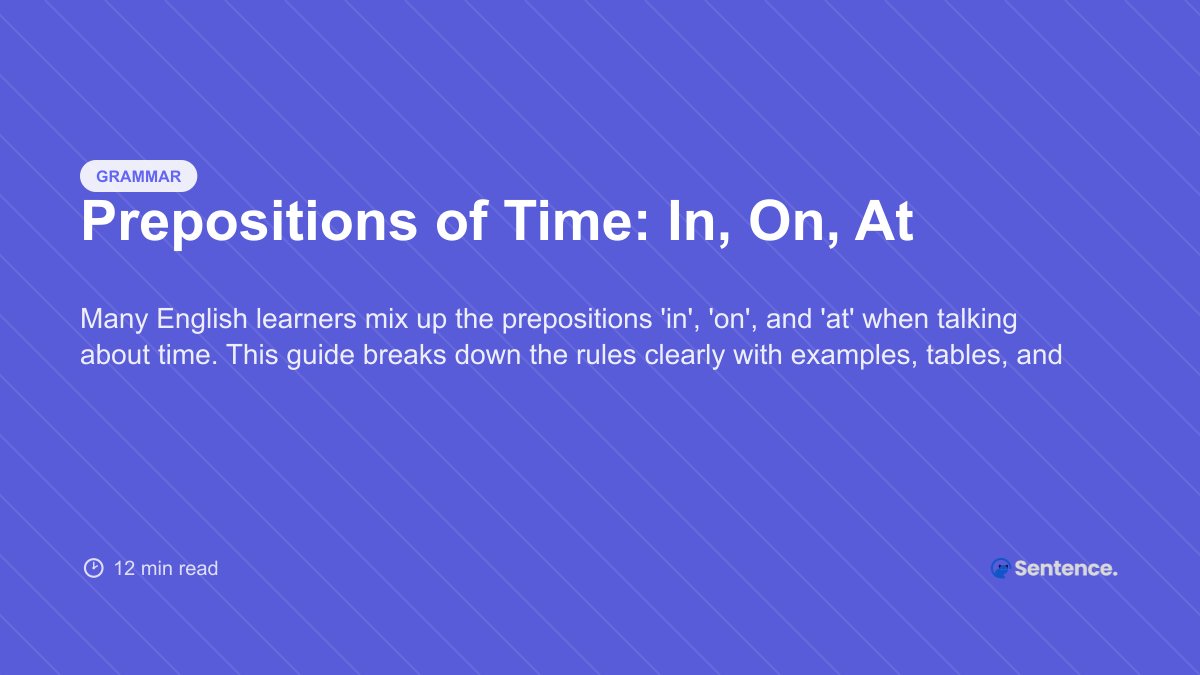
Prepositions of Time: In, On, At
Many English learners mix up the prepositions 'in', 'on', and 'at' when talking about time. This guide breaks down the rules clearly with examples, tables, and easy ways to remember them.

Many English learners mix up the prepositions 'in', 'on', and 'at' when talking about time. This guide breaks down the rules clearly with examples, tables, and easy ways to remember them.
Prepositions of time are one of the first grammar topics you learn in English, yet they continue to confuse even intermediate speakers. The words in, on, and at all refer to time, but each is used in very different situations. Once you understand the patterns behind them — from the biggest units of time to the most precise moments — everything starts to make sense.
Think of these three prepositions as tools for describing when something happens. The key is matching the right preposition to the level of detail you want to express. This guide will walk you through each one step by step, with clear examples and practical tips you can start using today.
The preposition in is generally used for longer, more general time periods. These are moments that aren’t tied to a specific point on the clock or calendar.
We use in with:
One way to remember this is that in works for the largest, least specific time frames. The time is wide, not exact.
| Use | Examples |
|---|---|
| Months | We will travel in July. |
| Years | The company was founded in 2005. |
| Seasons | Flowers bloom in spring. |
As we move to smaller, more specific units of time, we switch to on. This preposition is used when referring to particular days or dates.
We use on with:
A simple way to remember this is: if you can point to a specific day on a calendar, use on.
| Use | Examples |
|---|---|
| Days | He has a meeting on Tuesday. |
| Dates | The event is on April 20th. |
| Special Days | We celebrate on New Year's Eve. |
The preposition at is used when the time is precise — a specific moment rather than a broad period. It is the most exact of the three prepositions.
We use at with:
If you can measure the moment on a clock or see it happening instantly, at is the right choice.
| Use | Examples |
|---|---|
| Clock Times | We will start at 9:30. |
| Specific Moments | The store opens at sunrise. |
| Holiday Periods | They visit family at Christmas. |
Because different languages use prepositions differently, many learners mix them up. One of the most common issues is using “in” for specific dates or “on” for general periods of time. Another mistake is confusing “at night” with “in the night,” which actually has a different meaning in English.
Keep these quick reminders in mind:
Think of it like zooming in:
IN = wide view • ON = medium view • AT = zoomed in
To help you remember the rules more naturally, try these interactive practice ideas:
Answers: at / in / on / on
⭐ Pro Tip: If it’s a general period → use “in.” If it’s a day or date → use “on.” If it’s an exact time → use “at.”
Mastering the prepositions in, on, and at becomes much easier when you understand the level of detail each one expresses. These small words help clarify whether you’re talking about a broad period, a specific date, or an exact moment. With regular practice and careful observation, using them correctly will soon feel natural and intuitive.